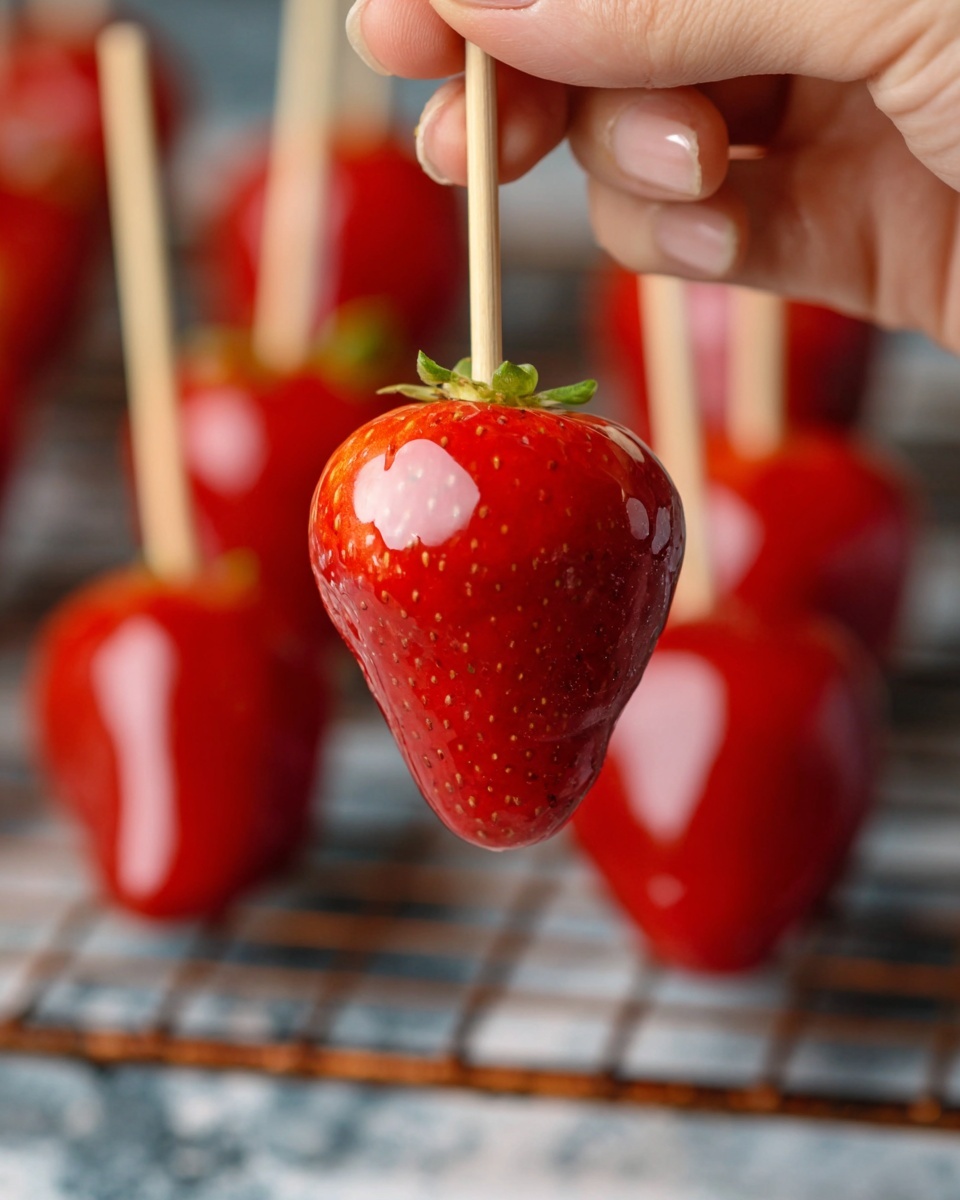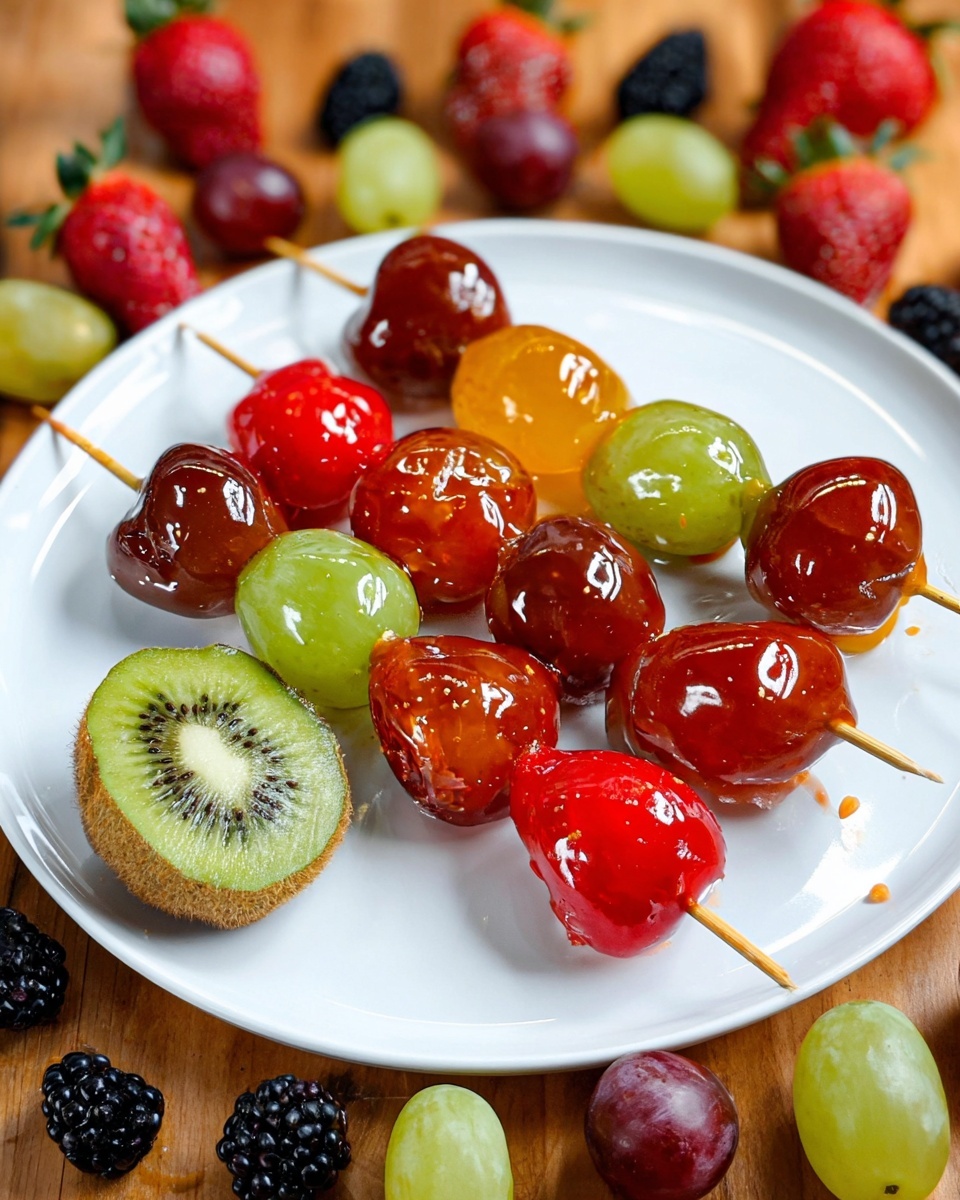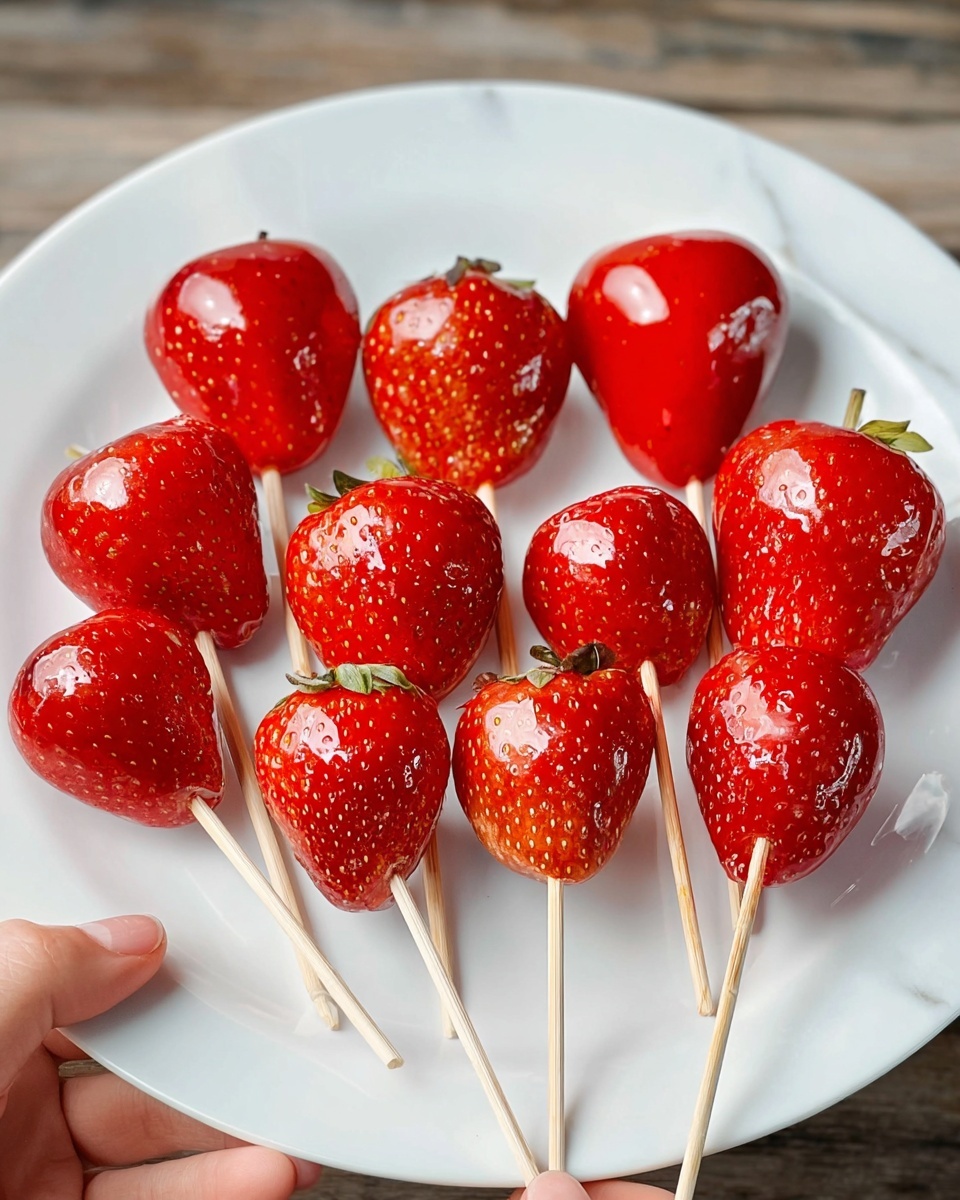If you’ve ever wandered through a bustling street market in China or spotted glossy skewers of fruit glowing like jewels in a shop window, you might have encountered tanghulu—those gorgeous, candied fruit treats that are both sweet and tart. I’m excited to share my foolproof method on How to Make Tanghulu (Candied Fruit) Recipe at home because the crunch of that hard sugar shell over juicy fruit is just unbeatable. Once you get the hang of it, you’ll find this recipe is as fun to make as it is to eat!
Why You’ll Love This Recipe
- Simple Ingredients: All you need is fruit, sugar, and water—easy to find and quick to prep.
- Show-Stopping Treat: The glossy, glass-like candy coating will wow your friends and family every time.
- Customizable Fruit: Use your favorite fruit or what’s fresh, making it your own tasty creation.
- Great for All Skill Levels: Whether you’re new to candy-making or a seasoned pro, these steps will guide you smoothly.
Ingredients You’ll Need
When it comes to making tanghulu, a few quality ingredients are all you need. I love using fruits that have a bit of tang and firmness so they hold up well under that sugary shell—and white sugar, not substitutes, gives you that perfect glossy finish.
- Strawberries and/or Blueberries: I love strawberries for their balance of sweetness and tartness, plus their juicy texture.
- Grapes: Seedless grapes work best for easy eating and a juicy pop.
- Kiwi slices or other firm fruit: If you like a tangier bite, kiwi adds a nice twist.
- White sugar: It creates that classic clear, shiny candy coating.
- Water: To dissolve the sugar and help form the syrup.
Variations
I love experimenting with tanghulu, and you really can let your imagination run wild here—the basics stay the same, but you can tweak flavors and styles to suit any occasion or craving. Give some variations a try and see what your family loves most.
- Use different fruits: I once tried small apple wedges and cherry tomatoes for a surprising tartness that my kids surprisingly adored.
- Mix berries and tropical fruits: Combining strawberries with pineapple chunks creates a fresh, vibrant contrast.
- Add a touch of spice: Dust the sugar syrup with a pinch of cinnamon before dipping for a warm flavor twist I learned from a spicy food lover friend.
- Vegan-friendly tweak: Stick to the classic recipe—no gelatin or animal products involved—making it naturally vegan and gluten-free.
How to Make How to Make Tanghulu (Candied Fruit) Recipe
Step 1: Prep Your Fruit Like a Pro
Start by washing your fruit thoroughly, then drying them really well. I can’t stress enough how important it is that the fruit is completely dry—any water left will prevent the sugar from sticking properly and mess with your glossy finish. Remove stems from strawberries and grapes, and slice larger fruits like kiwi into bite-sized pieces. Thread 1 or 2 pieces per skewer, keeping them near one end—it makes dipping and eating way easier.
Step 2: Make the Magic Sugar Syrup
Combine the sugar and water in a saucepan, then heat over medium. Don’t stir once it starts boiling; stirring can cause sugar to crystallize and ruin the smooth syrup. Have a candy thermometer on hand and cook until the syrup reaches about 300ºF (150ºC)—also known as the hard crack stage. If you don’t have a thermometer, try the ice water test: drip a little syrup into ice water, and if it hardens and cracks right away, you’re good to go.
Step 3: Dip and Chill for That Perfect Crunch
Once the syrup is ready, remove it from heat and tilt the pot slightly for easier dipping. Grab a skewer of fruit, dip it quickly in the hot syrup to coat all fruit pieces, then immediately dunk it into the ice water bath to harden that shiny candy coat. Lay the skewers on parchment paper or a wire rack to cool fully. Be fast because the syrup hardens quickly, but don’t hesitate if you need a moment between dips. Your tanghulu will turn out perfectly crisp!
Pro Tips for Making How to Make Tanghulu (Candied Fruit) Recipe
- Dry Those Fruits Thoroughly: I learned the hard way—wet fruit wrecks the candy shell, so pat dry with paper towels multiple times if needed.
- Don’t Stir the Syrup: Stirring once it boils can cause sugar crystals to form, making your syrup grainy instead of shiny.
- Use a Candy Thermometer: It’s the best way to know your syrup is at the perfect temperature, avoiding guesswork and burnt sugar.
- Work Quickly but Calmly: The syrup cools fast, so dip efficiently, but don’t rush and risk burns or uneven coating.
How to Serve How to Make Tanghulu (Candied Fruit) Recipe

Garnishes
I keep it simple with tanghulu—no extra garnishes needed. The candy coating shines on its own, and adding anything can spoil the crackly shell. That said, I sometimes sprinkle tiny edible gold leaf flakes for a festive touch when serving guests. It’s subtle but makes the treat look extra special.
Side Dishes
Since tanghulu is a sweet, snackable treat, I love pairing it with light, refreshing sides. A cold jasmine tea or a tangy yogurt dip complements the candy’s sweetness beautifully. Also, a small cheese board with mild cheeses balances the sugar for an adult-friendly snack.
Creative Ways to Present
For parties, I arrange tanghulu skewers upright in a pretty glass jar filled with crushed ice or decorative stones—like a sweet bouquet. Another idea I adore is draping a string of fairy lights underneath a platter for extra sparkle. Your tanghulu glimmers and becomes an instant conversation starter!
Make Ahead and Storage
Storing Leftovers
Honestly, tanghulu is best enjoyed immediately because the candy shell can become sticky in humid conditions. But if you have leftovers, store them in an airtight container at room temperature, never in the fridge or wrapped in plastic wrap, which can make the shell sweat and soften. They’ll keep for a day or two if stored properly.
Freezing
I don’t recommend freezing tanghulu—the texture of the fruit changes and the candy coating can crack or become cloudy after thawing. It’s a fresh treat best enjoyed right away for that satisfying crunch and juiciness.
Reheating
Reheating isn’t really possible with this one since the candy shell hardens once cooled. If any syrup gets sticky, you might try briefly chilling to harden again, but the fruit itself is best eaten fresh for optimal taste and texture.
FAQs
-
Can I use other types of sugar for tanghulu?
White granulated sugar is best for making tanghulu because it melts evenly and creates that beautiful, clear hard candy coating. Using brown sugar or powdered sugar can affect the syrup’s texture or color—brown sugar will make it darker and less transparent.
-
Why did my sugar syrup crystallize or become grainy?
Crystallization usually happens when you stir the syrup after it starts boiling, or if sugar crystals get stuck on the sides of your pan. To prevent this, avoid stirring once boiling and wipe down the pot sides with a wet pastry brush while heating.
-
Is it necessary to use a candy thermometer?
While not 100% required, a candy thermometer makes it so much easier to hit the perfect hard crack stage at around 300ºF (150ºC). Without it, you can use the cold water test to check syrup readiness but the thermometer adds reliability.
-
How long will homemade tanghulu stay fresh?
Best eaten within a few hours for the crispest shell and freshest fruit experience, but if needed, store them in an airtight container at room temperature to enjoy within 1-2 days. Avoid refrigeration or plastic wrap to prevent condensation and stickiness.
Final Thoughts
I absolutely love how tanghulu turns out with this recipe—the crackly shell paired with juicy, fresh fruit is such a delightful treat that always gets me excited to make it again. When I first tried making tanghulu myself, I struggled a bit with the sugar temperature, but once I mastered that, it became my go-to quick dessert for impressing guests or just indulging on a sunny afternoon. I’m confident you’ll enjoy making and sharing this recipe just as much as I do. So go ahead, grab your favorite fruit and try How to Make Tanghulu (Candied Fruit) Recipe—you’re in for a fun, delicious adventure!
Print
How to Make Tanghulu (Candied Fruit) Recipe
- Prep Time: 5 minutes
- Cook Time: 10 minutes
- Total Time: 15 minutes
- Yield: 10 or more skewers
- Category: Dessert
- Method: Stovetop
- Cuisine: Chinese
Description
Tanghulu is a traditional Chinese treat featuring fresh fruit coated in a shiny, hard candy shell. This recipe uses strawberries and other fruits like blueberries or grapes, dipped in a hot sugar syrup that hardens into a crisp, sweet shell, providing a perfect contrast to the juicy, tangy fruit inside. Perfect as a fun snack or a festive party treat.
Ingredients
Fruit
- 1 lb strawberries and/or blueberries, grapes, kiwi, or other fruit of choice
Syrup
- 2 cups white sugar
- 1 cup water
Instructions
- Prepare the fruit: Wash and pat dry the fruit thoroughly with paper towels. Remove green stems from strawberries, remove grapes from stems, and cut larger fruits like kiwi into bite-sized pieces.
- Skewer the fruit: Thread 1 or 2 pieces of fruit onto each skewer, keeping them at one end. Set the skewers aside for dipping.
- Make an ice bath: Fill a bowl with cold water and add a few ice cubes. This will help the sugar coating harden quickly.
- Cook the sugar syrup: In a medium-sized saucepan over medium heat, combine sugar and water and bring to a boil without stirring. Let the syrup cook until it reaches around 300ºF (150ºC), about 5-10 minutes, or until it turns amber and can form brittle threads when drizzled into the ice water.
- Remove syrup from heat: Once the syrup reaches the correct temperature, carefully remove the saucepan from heat and tilt it slightly to make dipping easier.
- Dip the fruit: Quickly dip each skewer in the hot syrup, fully coating the fruit, then immediately dip it into the ice water to harden the candy shell, and lay it on a wire rack or parchment-lined tray.
- Repeat and set: Continue dipping all the skewers, then let them rest for several minutes so the candy shell can fully harden.
- Serve: Enjoy your freshly made tanghulu as a crunchy, sweet-and-tart snack immediately.
Notes
- Choose firm, juicy fruits with a tangy or sour flavor like strawberries, grapes, blueberries, kiwi, orange wedges, hawthorn berries, kumquats, cherries, apples, tangerines, pineapple, or cherry tomatoes for best results.
- Tanghulu is best eaten right away. Leftovers can be stored in an airtight container at room temperature but avoid plastic wrap and refrigeration to prevent moisture softening the candy shell.
- Use a candy thermometer for accuracy, or the ice water test to check syrup readiness.
Nutrition
- Serving Size: 1 skewer
- Calories: 150
- Sugar: 38g
- Sodium: 0mg
- Fat: 0g
- Saturated Fat: 0g
- Unsaturated Fat: 0g
- Trans Fat: 0g
- Carbohydrates: 39g
- Fiber: 1g
- Protein: 1g
- Cholesterol: 0mg



